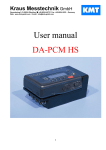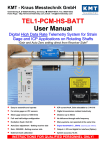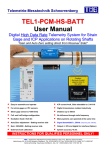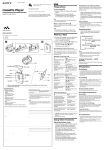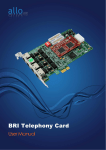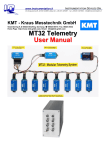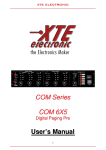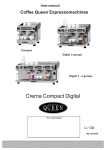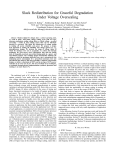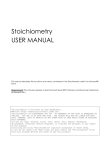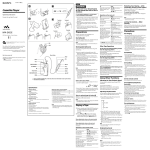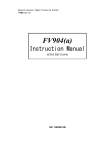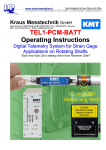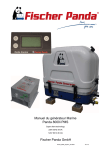Download User manual D-2/16
Transcript
Kraus Messtechnik GmbH Gewerbering 9, D-83624 Otterfing, +49-8024-48737, Fax. +49-8024-5532 – Germany Web: www.kmt-gmbh.com E-mail: [email protected] User manual D-2/16 Operating instructions tape deck Inserting a Cassette 1 Press and hold down the small button and slide the HOLD/PUSH OPEN-switch to the OPEN position. HOLD/PUSH OPEN-switch While pressing 2 3 Open the cassette compartment door. Notes When disconnecting the unit from the power source, make sure the cassette compartment door is closed. Otherwise, you may not be able to close it afterward. If this happens, re-connect the power source. When inserting a cassette, make sure that the side with which the tape is visible inside is facing upward. If you inset the cassette upside down, you may not be able to take the cassette out. To eject the cassette While the unit is in the stop mode, press and hold down the small button and slide the HOLD/PUSH OPEN-switch to the OPEN position. Insert a cassette with the window facing upward. HOLD/PUSH OPEN While pressing Record-protect shutter Slide the record-protect shutter to the left to protect a recorded tape from being accidentally erased by recording on the tape for the second time. 4 Close the cassette compartment door. If the shutter is open, you cannot record on the tape The cassette will be loaded automatically. If the shutter is closed, you can record on the tape To Record SP/LP out of function HOLD/PHUSH OPEN out of function 1 2 3 REC out of function REC Insert a DAT cassette Press the REC button and the yy PAUSE-button. The unit enters the pause mode. Press either the ¾ PLAY-or the yy PAUSE-button. The recording starts. Notes The recording cannot be started by just pressing the REC button, instead, the unit enters the recording monitor mode. The unit can enters the recording monitor mode whether the record-protect shutter of the cassette is open or not. Recording is possible only when the shutter is closed. To stop recording Press the STOP-button. To pause recording momentarily Press the yy PAUSE-button. To cancel the pause mode Press the yy PAUSE-button again or press the ¾ PLAY-button. Notes If the unit is left in the pause mode for more than five minutes, the unit will automatically enter the stop mode in order to protect its head and the tape. Version 2007-08 3 Technical Data are subject to change without notice! Notes on Recording SP/LP out of function out of function HOLD/PHUSH OPEN REC out of function REC Do not leave any unrecorded parts on a DAT tape. If there is a blank (unrecorded) part left on a DAT tape, the absolute time* will not be written thereafter. Also, when the tape is being fastforwarded or rewound, it will stop at that point. In order not to leave any unrecorded parts on a tape while recording, observe the following: To avoid any accidental operation (Hold function) Slide this switch to the HOLD position to avoid any accidental operation while the unit is set in a particular operational mode. z If you intend to continue to record on a tape which is partially recorded, make sure that you find the end of the previous recording first, then the start the new recording from that point without leaving any unrecorded gap. (If you fast-forward the tape, if should automatically stop where the previous recording has ended.) This signal indicates the beginning of a recorded program (track). By reading these start ID signals, the unit can cue the beginnings of the recorded programs (tracks) automatically. *The absolute time indicates the elapsed time from the beginning of the tape and the current position of the tape which is written digitally. The absolute time will be automatically written when you record a DAT tape for the very first time and cannot be erased once written. (In the HOLD Position are all switch lock!) .................................................................................... Start ID tape transport direction program (track) program (track) program (track) start ID To write the start IDs automatically while recording This start codes are set by each new recording, also by using the "Pause button" by recording. To write the start IDs manually while recording While recording, press the REC button at the point When you record to the end of a DAT tape The tape automatically rewinds to the beginning where you wish to write the start ID. and will stop there. (Auto-rewind function) Note While writing the start IDs, the W R I T E indication comes on and the START-ID - indicator flashes for about nine seconds. While the unit is set in this mode, no operational buttons other than the STOP button will function. Version 2007-08 4 Technical Data are subject to change without notice! Playback out of function 1 2 Insert a DAT cassette Cleaning the Head Press the ¾ PLAY-button. Playback starts. The SP/LP switch is out of function. Prolonged operation may cause contamination of the head. To make the best possible recording and playback, we recommend you to clean the head periodically, using the cleaning cassette DT-1OCL (not supplied)*. To stop playback Press the STOP-button. How to use the cleaning cassette 1 Insert the cleaning cassette as you would a normal DAT cassette. To pause playback momentarily Press the yy PAUSE-button. To cancel the mode, press either the yy PAUSEbutton or the ¾ PLAY-button. 2 Press the ¾ PLAY button, then press the 3 STOP button after about 10 seconds. 3 Remove the cleaning cassette without Notes rewinding it. If the unit is left in the pause mode for more than five minutes, the unit will automatically enter the stop 4 Proceed with recording and playback with a mode in order to protect its head and the tape. normal DAT cassette and check the sound quality. To fast forward the tape Press the ¾¾/¾¾I button when the unit is in the stop Notes on the cleaning cassette mode. z The cleaning cassette cannot be used for recording or playback. To rewind the tape Press the I½½/½½ - button when the unit is in the z Do not clean the head with the cleaning stop mode. cassette more than five times in succession. Cleaning the head continuously for a long When a tape is played back to the end period of time may cause wear to the head. The tape will be rewound to the beginning automatically and the unit enters the stop mode. z Do not rewind the cleaning cassette each time (Auto-rewind function) you use it. When the cleaning cassette tape is taken up (wound) completely, rewind it to the beginning and reuse it. The cleaning cassette can be used approximately 200 times, with 10 seconds of cleaning each time. Version 2007-08 5 Technical Data are subject to change without notice! Locating the beginning of a program (track) out of function out of function Press either ¾¾/¾¾I or I½½/½½ button quickly once during playback. If the unit is in the fast forward/rewind mode, press either the ¾¾/¾¾I or I½½/½½ button once. Or if the unit is in the stop mode, press either the ¾¾/¾¾I or I½½/½½ button twice. To locate the beginning of the succeeding program (track) Press ¾¾/¾¾I the same number of times as the programs (tracks) to be skipped. E.g. to locate the beginning of the fifth program (track) To locate the beginning of the previous program (track) Version 2007-08 Press ¾¾/¾¾I the same number of times as the programs (tracks) (including the currently played one) to be skipped. 6 E. g. to locate the beginning of the fourth program (track) including the currently played one Technical Data are subject to change without notice! Display Day/AM/PM-indicator Tape counter/clock/message indicator z The tape counter indications z Clock display Each time you press the COUNTER button, the display changes cyclically as follows: Each time you press the CLOCK button, the display changes cyclically as follows: Tape counter (normale display) RECORDED TIME* (date of the recording) Absolute time RECORDED TIME* (time of the recording) Remaining time of tape Current date (year, month, date) To reset the tape counter (normal display) to Current time (hour, minute, secound) 00H00M00S Press the RESET button. *The RECORDED TIME will not be displayed while the unit is in the recording, recording monitor, or pause mode. Remaining time of the tape The remaining time left on the tape will normally come on after about 16 seconds of commencing playback in the SP mode. However, there may be some aberration in the amount of time displayed which depends upon the tape you use. Note The tape counter should not be used as a clock What is being displayed on the counter is not completely accurate in terms of displaying the actual time. Therefore, do not use the tape counter as a clock. Version 2007-08 7 Technical Data are subject to change without notice! Setting the Clock The unit automatically registers the date of recording (year/month/date/day/hour/minute/ second) at the time of recording. The date of recording can be then displayed on the display window while the unit is playing back, fast forwarding/rewinding or cueing/reviewing a tape (Date function). It is essential to set the clock before any recordings are made. Otherwise, the date function will not work properly and the correct date and time of a recording will not be registered on the tape. Proceed with the following steps while the unit is in the stop mode. 1 Press the CLOCK/SET button for more than four seconds. 5 Press the COUNTER/- and RESET/+ buttons to set the day, then press the CLOCK/SET button. 2 Press the COUNTER/- and RESET/+ buttons to set the year digits, then press the CLOCK/SET button. 6 Repeat steps 2 to 4 to set the correct current time (hour/minute/second). The second digits change to "00" when the COUNTER/- or RESET/+ button is pressed and the clock starts activating when the CLOCK/SET button is pressed. Therefore, synchronize the clock by pressing either - or + button with the radio time-signal etc. 3 Press the COUNTER/- and RESET/+ buttons to set the month digits, then press CLOCK/SET-button. The flashing will stop and the clock will start activating.. 4 Press the COUNTER/- and RESET/+ buttons To cancel the procedure Press the STOP button. The clock display will return to the previous time display. However, if you have proceeded to step 6, the year, month, day and date will be set. to set the date digits, then press the CLOCK/SET button. 12/24 hour display To select either the 12-hour or the 24hour clock display. Press the RESET button for more than two seconds. Version 2007-08 8 Technical Data are subject to change without notice! Precautions On Safety Should any solid object of liquid fall into the unit, unplug the unit and have it checked by qualified personnel before operating it any further. On Installation Do not install the unit in a location near heat sources such as radiators or air ducts, or in a place subject to direct sunlight and excessive dust. On Moisture Condensation If the unit is brought directly from a cold to a warm location, moisture may condense inside the unit. In such a condition, the tape may adhere to the head drum and can be damaged, or the unit may not operate properly (the 6-indicator has come on). Always remove the DAT cassette from the unit when the unit is not to be used for an extended period of time. If moisture is present Operating buttons and controls may not function properly. The unit may shut off. Version 2007-08 9 Technical Data are subject to change without notice! Operating instructions D-2/16 1) Power on: Turn the Channel mux. switch to the right with a screwdriver to select mux mode and bandwidth. The power is switched on, but the D2/16 needs about 5-6 seconds to get ready. Attention: In REC-mode, the MUX-mode position and the data will be recorded. In PLAY-mode the muxmode is read from the tape. 2) Record: Check the write-protection at the cassette, press and hold down the small button and slide the HOLD/PUSH OPEN, insert the cassette with the windowfacing upward and close the cassette compartment door. The cassette will be loaded automatically, see "Inserting the cassette". Press "REC", and the D2/16 is in a waiting status, ( it still doesn't record). In this mode the system is working as if you are recording, except that the tape doesn't move. It enables you to use the system as a normal signal conditioning unit as front-end to the PC . Attention: Analog input is on the rear side and the output on the front. Important note for Calibration test when using the analogue output: The calibration data must be recorded, then read in Play mode. (In Rec. mode the output filter is not active) 2.1) The overload diodes indicate which channel inputlevel exceed +/- 5V. With a pin switch you can reset the display. 2.2) Instead of the BNC input/output, you can use the 9 pole Cannon input/output connector. 2.3) The second time you press "Pause", the pause mode stops and the tape moves again, (rec + play status). Simultaneously the startcode is recorded. Attention: It takes about 9 seconds to record the startcode, simultaneously together with the data, ( you see "START ID" blinking on the display). During this time you must not stop the tape, because the startcode won't be completely recorded and you may not find it later on. 2.4) At each REC START a new startcode will be recorded. Further startcodes can be set during recording by pressing "REC". 2.5) Ascending startcode are only possible if you start recording from the beginning of the tape. In this case the startcodes will be counted, stored as a PGM-number and displayed in the PGM-window. Attention: Don't forget to secure the tape after recording, (with the switch). 2.6) Parallel to the analog signals, it's possible, via PCM-input, to record and reproduce static signals or pulses, 0-10 kHz, (TTL-Level). When using our small 16 channel programmable signal conditioning unit PSC 16, it's possible to use this input, to record the default setup. 2.7) By using the handy microphone, with built in loudspeaker, it's possible to make comments to the recording. To record, just press the switch on the microphone. The reproduction is automatically. 2.8) For external microphone systems we can deliver a galvanic isolated input as an option. 2.9) With these possibilities, including recorded date and time, it's possible to reproduce all default parameters, also after some years. 3) Play: Insert the cassette and press "PLAY". All recorded data are available at the corresponding connector output. Input overload won't be displayed. Recorded digital pulses via PCM output, 0-10kHz can be reproduced with a rest jitter of 10 µs. ( The samplingrate of the PCM- or the digital input is 96 kHz.) 4) Remote control: The remote control is together with the power supply connected via the PWR connector ( see connectionplan). The recording can be started in two different ways. 4.1) Connect a positive potential to pin B of connector PWR,( see plan). This potential must be between +3V and +30V The recording continues as long as this potential remains, ( at least 15 sec. to make sure that the whole startcode is recorded). Attention: Before inserting the cassette, make sure that no write protection is done. The message TAPE PROTECT will appear on the display but not via the remote control. Version 2007-08 10 Technical Data are subject to change without notice! 4.2) Event: There can be connected two different eventdetectors, in OR-mode, (pin 1 or 3 of the PWR-connector). These potentials must be between + 3V and +30V, with a duration of at least 3 sec. In this case a recording of at least one minute will be started, but maximum one minute more than the event potential duration. 4.3) Attention: This remote control can only start and stop in write mode. The DAT-recorder must be in REC+PLAY-mode, if not, the remote control signals will be ignored. 5) Date and time: How to set it, pls. see "Setting the clock" . One built in Lithium battery supplies the date and time after the power is switched off. It has a life time of about one year. To replace it, just open the battery compartment door, (unscrew the two imbus-screws). Remove with an iron the ++ and -- wires and connect it with the new battery, the red wire is ++, the blue wire is --. Don't change. 6) Common hints: 6.1) The D2/16 needs a DC-powersupply with 8-32V. The PWR-connector M&H + and E&D-. There is no groundprotection. When you connect a power supply unit, pls. follow the common safety instructions. 6.2) The total samplingrate is fixed at 96 kHz. All channels are filtered and simultaneously sampled. The sample rate per channel is depending on the muxmode. Just devide 96 kHz by the number of channels and you get the sample rate per channel. The filters will automatically be switched to the max. cut off frequency in record- as in replay-mode. The resolution is 12 bit , it means at a amplitude of +/- 5V=10V your LSB is 2,5 mV, (4096 steps). 6.3) The drive processor recognises cassettes with a max. runtime of 2 hours ( tape length of 60 m). Attention : Cassettes with a length of 90 m. ( 3 hours runtime ) can be used but sometimes the displayed remaining time will not be correctly recognised from the processor. 7) Other matters: We recommend : Use only high quality cassettes and clean the head periodically, using the cleaning cassette DT-10CL ( not supplied). If you get any errors, the most common reason is a bad tape or a dirty head. Sometimes it's enough, just to cut the power for a second. 8) For further operating instructions and details: Pls. see following pages. Version 2007-08 11 Technical Data are subject to change without notice! 9) Remote Control Box with bargraph display, audio record and replay. 9.1 Connection: Connect the 9 pole cable at the audio connector of the DAT-recorder. 9.2 Record: Keep the Record button pressed and press the Play button. Check that the Rec.- and Play LED’s getting active. At the bargraph display all active channels will be displayed. An overload (>±5V), will be indicated by one flashing sign or more. It keeps on flashing above or below the corresponding channel until the Stop or OVL/Reset button is pressed. When record is activated by an EVENT, (see section 4.2) the Rec.- and the Event-LED’ s are lightning up. 9.3 Play: Just press the Play button. Above described functions ( see section 9.2) are still valid. 9.4 Audio: By pressing the Voice/Record button, at the side of the remote control, during „RecordMode“, the speech channel will be recorded together with the data. Replay is automatically done in „Play mode“ Version 2007-08 12 Technical Data are subject to change without notice! 10) Technical Data 10.1 Tape deck Tape Track width Tape speed Density Bitrate Storage capacity DAT-tape width 3,81 mm ca. 13,6 µm 8,15 mm/s 61kbit/inch 1,536 Mbit/s or 192 KByte/s 1,38 GByte for 2 hours recording 2,07 GByte for 3 hours recording (not recommended) 10.2 Analog inputs Selection Input range Input impedance Filter Resolution Common scanningrate 2, 4, 8, 16 ±5 V 100kΩ Low pass, 8. order Butterworth, Cut off frequency 48 DB/octave 12 Bit, simultan S+H for all channels 96 kHz 10.3 Analog Outputs Selection Output range Output impedance Filter Resolution 2, 4, 8, 16 ±5 V 2 Ω, max. 10 mA 8. order , low pass Butterworth 12 Bit, simultan S+H 10.4 Digital Input/Output PCM Bitrate Remaining jitter Level 0 ... 20 kHz 10µs TTL 10.5 Audio channel Build in microphone and speaker Signal bandwidth 100 Hz ... 3000 Hz galvanic isolated microphone inputs Optional 10.6 Interface serial Data, wordclock, frameclock at IF 16 Interface card in the computer 10.7 Remote control Level 3 ... 30V positive 10.8 System accuracy ±0,1% at 0 Hz, Difference of Phase delay for all channels at the same frequency better 0,5° 10.9 Error correction Double encoded Reed Solomon Code, biterror rate better 10-10 10.10 Anaolg Signalbandwidth - Scanningrate Signalbandwidth Channel Mux Version 2007-08 2 CH 16 kHz 4 CH 8 kHz 8 CH. 4 kHz Scanningrate 16 CH. 2 kHz 2 CH. 48 kHz 13 4 CH. 24 kHz 8 CH. 12 kHz 16 CH. 6 kHz Technical Data are subject to change without notice! 10.11 Powering Input Optional 8 ... 32 V DC ca. 10 Watt AC 100 ... 240 V 50/60 Hz 10.12 Dimensions 150 x 85 x 90 mm without shock absorber 10.13 Weight ca. 1,5 kg without shock absorber 10.14 Environmental Operating temperature Storage temperature Humidity Vibration Shock -5 °C to +45 °C -20 °C to +60 °C 20 ... 80% no condensing 5g Mil Standard 810C, Curve C 10g in all direction Technical specifications subject to change without notice! Version 2007-08 14 Technical Data are subject to change without notice! Battery replacement Pin connection Battery replacement: Lithium battery TYPE Sonnenschein SL340 The battery is used for storage of the date and time during power off. The life time of the battery is approximately 1 year. With a completely discharged battery the date and time values will be lost when power is off. Battery change is carried out by removing the two screws of the battery cover on the DAT recorder right side and insertion of a new battery, Old battery connections have to be removed by using a soldering iron. (WARNING !!! Do not exchange the red and blue wires!). The red wire is to connect to the ++ connection and the blue to -- one when re-soldering the connections of the new battery. Version 2007-08 15 Technical Data are subject to change without notice! Pin connection: Analog In 1...8 9 pol. Cannon Pin Signal 1 Channel 1 2 Channel 2 3 Channel 3 4 Channel 4 5 Channel 5 6 Channel 6 7 Channel 7 8 Channel 8 9 GND Analog In 9...16 9 pol. Cannon Pin Signal 1 Channel 9 2 Channel 10 3 Channel 11 4 Channel 12 5 Channel 13 6 Channel 14 7 Channel 15 8 Channel 16 9 GND Analog Out 1...8 9 pol. Cannon Pin Signal 1 Channel 1 2 Channel 2 3 Channel 3 4 Channel 4 5 Channel 5 6 Channel 6 7 Channel 7 8 Channel 8 9 GND Analog Out 9...16 9 pol. Cannon Pin Signal 1 Channel 9 2 Channel 10 3 Channel 11 4 Channel 12 5 Channel 13 6 Channel 14 7 Channel 15 8 Channel 16 9 GND Version 2007-08 16 Technical Data are subject to change without notice! PCM In/Out 9 pol. Cannon Pin Signal 1 reserved 2 reserved 3 GND 4 reserved 5 reserved 6 PCM Out TTL 7 RXD 8 TXD 9 PCM In TTL Audio / Remote control box 9 pol. Cannon Pin Signal 1 RCB Clock 2 RCB Out 3 RCB In 4 Loudspeaker Out 5 Microphone In 6 reserved 7 reserved 8 +5V 9 GND Interface 4 pol. Lemo Pin Signal 1 +5V 2 PCM Data + 3 PCM Data 4 GND PWR 7 pol. Tuchel Pin Signal 1 Remote min 15 sec 2 ++9-32 V 3 Event min 60 sec. 4 GND 5 -- 9-32 V WRC (write contr.) 6 7 not connected Version 2007-08 17 Technical Data are subject to change without notice! Version 2007-08 18 Technical Data are subject to change without notice! ECIA100 PCMCIA Interface Option To transfer digital datas via MLab (acquistion software) in PC Version 2007-08 19 Technical Data are subject to change without notice!




















